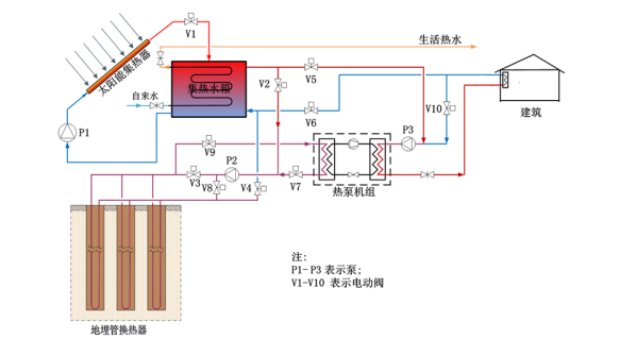分布式太阳能采暖系统
n 以户或少量建筑为单位,利用其屋面等空间,设置独立的太阳能及储热、辅热系统,不进行长时间热量储存,用于满足建筑的采暖、供热水需求。
n Set up independent solar energy, heat storage, and auxiliary heat systems on the roof and other spaces of households or a small number of buildings, without long-term heat storage, to meet the heating and hot water supply needs of the building.
n 广泛应用于煤改清洁能源推广行动中;
n Widely used in the promotion of coal to clean energy;
n 太阳能可以辅以空气源热泵、电或燃气炉等器具;
n Solar energy can be supplemented by appliances such as air source heat pumps, electric or gas stoves;
n 产权独立,无集中管网,独立使用,无后期管理与收费等相关问题;
n Independent property rights, no centralized pipeline network, independent use, no issues related to later management and fees。
● 系统原理图

分布式太阳能采暖系统原理图
● 运行原理
在晴好天气下,利用套管式真空管太阳能集热系统对采暖水箱进行加热后向建筑物供热,以保证房间温度达到设定需求;在连续阴雨或阳光强度不足时,房间温度低于设定需求但太阳能集热系统无法保证供暖出水温度时,启动电加热等其他辅助热源加热,保障建筑物正常采暖需求。
1、太阳能集热
太阳能集热系统采用温差循环方案,太阳能集热循环泵根据集热器出口温度与水箱温度差进行启停,当温差较大时,太阳能循环泵启动,对水箱进行加热,保证优先利用太阳能资源;当天气条件不好温差较小时,太阳能循环泵停止。
2、辅助方案说明
在夜间或寒冷天气情况下,当太阳能加热后的水箱温度无法满足采暖需求时,启动电加热(或其他辅助热源)进行加热后,提升供暖出水温度,保障采暖需求。
3、采暖方案说明
供暖系统根据室温设定进行自劝化控制;当采暖房间温度低于设定需求值时,控制器自动启停采暖循环泵,保证采暖温度;房间温度达到设定值时自动停止。
4、防冻控制
屋顶太阳能及管道采用导热油为换热介质,能保证适应-50℃高寒高海拔气候,完全避免了太阳能采暖系统中的冻损问题,相较于电伴热、管道热循环等防冻方式更加安全,更加节能。
5、补水
采暖系统为闭式循环,补水量较小;当采暖系统水量缺失采暖水箱水位下降时,通过浮球阀自动向水箱中补水。
● 应用场景
分布式太阳能采暖系统可广泛用于单体低层建筑中,尤其适用于农村居住建筑及村委会、活动中心、卫生院、养老院等办公建的采暖中;该技术已在“新农村建设”以及全国“煤改清洁能源”项目中得以广泛应用等。
太阳能跨季节储热供热系统—适用于区域性供热应用

太阳能跨季节储热供热系统主要包括太阳能集热、跨季节储热、辅助热源和供暖系统等。通过太阳能集热系统和跨季节储热系统,将非采暖季比较丰富的太阳能以热能的形式收集并储存在跨季节储热系统中供冬季采暖使用。跨季节储热常用的储热介质为水和土壤。
n 通过太阳能集热系统和跨季节储热系统,将非采暖季比较丰富的太阳能以热能的形式收集并储存在跨季节储热系统中供冬季采暖使用。跨季节储热常用的储热介质为水和土壤。
n By using solar energy collection systems and cross seasonal heat storage systems, the abundant solar energy in non-heating seasons is collected and stored in the form of thermal energy in the cross seasonal heat storage system for winter heating. The commonly used heat storage media for cross seasonal heat storage are water and soil.
n 集中式太阳能蓄热采暖、供热技术方案,一般是在建筑物周边空地集中建设太阳能集热系统及机房;
n The centralized solar energy storage heating and heating technology scheme generally involves the centralized construction of solar energy collection systems and computer rooms in the open space around buildings;
n 埋管储热一般利用地下土壤储存热量,地埋管蓄热装置是打入地面以下的竖井内设置单U形管或双U形管,在蓄热过程中,将太阳热能通过水等介质储存在土壤和岩石中,到冬季供暖时,再通过水等介质将竖井旁边土壤和岩石中的热量交换出来。
n Buried pipe heat storage generally utilizes underground soil to store heat. Buried pipe heat storage devices are installed in vertical shafts below the ground with single or double U-shaped pipes. During the heat storage process, solar thermal energy is stored in soil and rocks through media such as water. During winter heating, the heat in the soil and rocks next to the shaft is exchanged through media such as water.
n 通过集中的供热循环管网,将太阳能集热、地下埋管蓄热的热量向各个建筑物输送,作为各户的采暖及热水热源。
n Through a centralized heating circulation network, the heat from solar energy collection and underground buried pipe storage is transmitted to various buildings as a heating and hot water source for each household.
浙江可知秉承“专业价值、服务典范”的核心理念,以优质的产品、全面的服务和创为新能源,清洁能源提供全套解决方案,业务涵盖智慧电源,清洁能源,智慧电源,智慧太阳能等专业化能源管理平台解决方案运营等全产业链板块,充分满足客户基于智能能源多样化的需求。
浙江可知研发技术精英团队人数占比达20%,掌握多项自主核心技术和知识产权;拥有自主投建的3万㎡生产基地;经验丰富的专业化运营服务团队24小时待命,满足客户所需技术支持和运营服务;基于“云技术+互联网+移动支付+人工智能”基础打造的“本地+云端”双重服务体系,全面保障了设备运维、发电故障等需求。
未来,浙江可知将坚持智慧价值运营商的核心主张,持续深化技术实力和产品品质,通过加强产业链上下游共同合作、整合服务资源,致力于不断为企业、社会和消费者创建清洁的共享能源系统。
